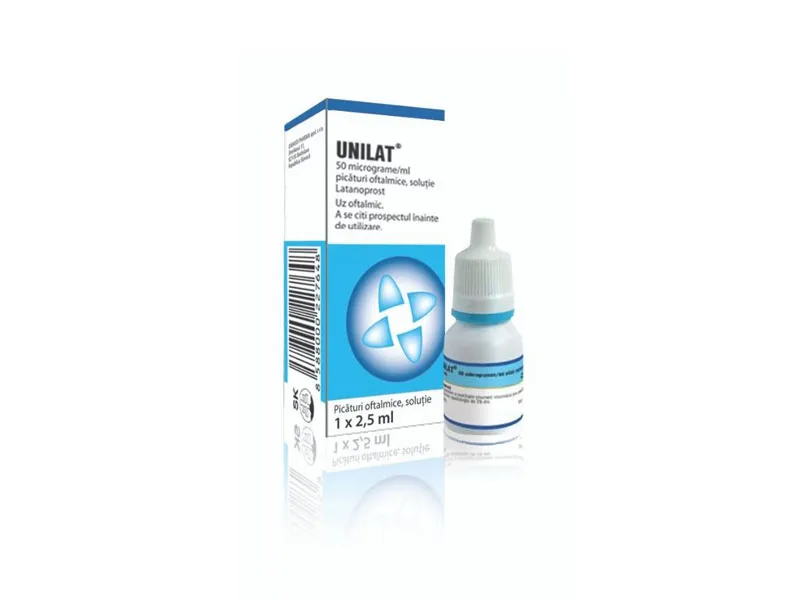Annotation
Composition:
1 ml of eye drop solution contains 50 micrograms of latanoprost.
1 drop contains approximately 1.5 micrograms of latanoprost.
Pharmacological properties:
Unilate belongs to the prostaglandin analogues group of drugs.
Its main mechanism of action is related to intraocular fluid
with the reinforcement of expulsion.
Recommendation for use:
Unilate is used for open-angle glaucoma and elevated
In patients with ophthalmotonus. Both of these conditions are associated with increased intraocular pressure, which affects vision.
Unilate can also be used to treat intraocular pressure and glaucoma.
For treatment in infants and children of any age.
Indications:
- Unilate is used for open-angle glaucoma and elevated;
- In patients with ophthalmotonus. Both of these conditions are associated with increased intraocular pressure, which affects vision;
- Unilate can also be used to treat intraocular pressure and glaucoma;
- For treatment in infants and children of any age.
Dosage:
Dosage and method of administration:
Usually, the dose for adults (including the elderly
For individuals and children, it is one drop once a day
In the affected eye(s). Instillation is best done in the evening
in hours.
Do not use Unilate more often than once a day. In case of frequent use of the drug, it is possible to reduce its effectiveness.
Unilat is used by your or your child’s doctor with specified instructions and duration.
Contraindication:
Do not use Unilat in the following cases:
- If you have an allergy (hypersensitivity) to latanoprost or any of the other ingredients included in the preparation (see the list in section 6);
- Pregnancy period or if you are trying to conceive;
- Lactation period.
Side effects :
- Eye redness;
- Eye irritation (burning, stinging, itching, feeling of a foreign body in the eye);
- A gradual change in eyelashes and eyebrows, mostly in people of Asian descent. These changes are lengthening, thickening, increased pigmentation, increased frequency.
- Common (may affect up to 1 in 10 people)
- Eye irritation, inflammation of the eyelids (blepharitis), eye pain and increased sensitivity to light;
- Uncommon (may affect up to 1 in 100 people)
- Swelling of the eyelids, dry eyes, inflammation and irritation of the eye (keratitis), blurred vision and conjunctivitis;
- A rash Rare (may affect up to 1 in 1,000 people):
- Inflammation of the colored membrane of the eye (iritis, uveitis);
- Swelling of the retina (macular edema), swelling around the eye (periorbital edema), damage to the surface of the eye, change in the direction of eyelash growth;
- Skin reactions, eyelid skin discoloration; Asthma, asthma exacerbation or shortness of breath (dyspnoea). Very rare (may affect up to 1 in 10,000 people);
- Exacerbation of angina pectoris in patients with heart disease, chest pain.
- Patients have also reported macular edema, including cystic (a cyst of the colored membrane of the eye), headache, dizziness, palpitations, muscle pain, joint pain, eye infection caused by herpes simplex virus (HSV).
- Very rarely, in patients with corneal damage, the development of dark spots on the cornea has been described, which is related to the accumulation of calcium during treatment.
- Additional side effects occurred more often in children compared to adults: asal itching and fever.
WARNING:
WARNING AND PRECAUTIONS
Before using Unilat in adults or children, talk to your doctor or your child’s doctor if you think any of the conditions listed below apply to you or your child:
- Planned or performed eye surgery (among them due to cataract);
- Vision-related problems (for example, pain,
- irritation or inflammation, blurred vision);
- dry eye;
- Severe asthma or difficult-to-manage asthma;
- Wearing contact lenses. Despite the fact that the use of unilat is possible at this time, follow the instructions for wearing contact lenses, which are indicated in chapter 3;
- Viral eye infection caused by herpes simplex (HSV).
Use of Unilate with food and drink
The drug is an ophthalmic solution, it is not intended for use
Related to food and drink.
Pregnancy and lactation
Unilat is not used during pregnancy.
If you are pregnant, think you are pregnant, plan
If you are pregnant and have a baby on a natural diet, consult your doctor or pharmacist before using this medicine.
Unilat is not used during lactation.
If you or your child wears contact lenses, they should be removed before instilling the medicine. Lenses can be re-made after 15 minutes. See the relevant instructions in Section 3.
Storage method:
Keep out of the reach of children.
This medicine is not used on cardboard packaging and bottles
After the specified expiration date. as the expiration date
The last number of the specified month is considered.
Before the first opening: store in a refrigerator (at a temperature of 2-8⁰C). It does not freeze. Store in a place protected from light, in the original packaging.
After first opening: store at a temperature not exceeding 25⁰C.
After first opening, use within 28 days.
Unilat is stored in a place protected from light, in the original packaging.
Do not use Unilate if there is visible damage to the outside of the bottle or if you notice that the protective film is damaged. In this case, return the drug to the pharmacy.
It is not possible to dispose of the medicinal product in running water and
in household waste. unused medicinal product
Consult a pharmacist regarding liquidation. These measures help
They will contribute to the protection of environmental conditions.
Packaging:
Release form: Unilat is a clear, colorless solution without visible particles.
Each bottle contains 2.5 ml of eye drop solution.
Not all packages may be available for sale.
Marketing license holder
Manufacturer: UNIMEDPHARMA Ltd., Bratislava, Slovak Republic

